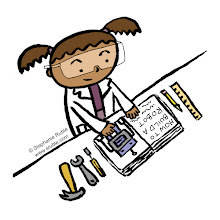If you're a new children's book illustrator (or writer) you might not know that the path illustrators take to get their work noticed is not the same one that writers take.
The path illustrators take to get their work noticed and advance their careers:
1. Develop a style.
2. Create a strong portfolio.
3. Create a website to post your portfolio so art directors and editors can find you and see your work.
4. Research publishers/editors/art directors/agents and create a mailing list.
5. Create postcards, have them printed, pay for postage, take the time to address them, and mail them to your list.
6. Continue to create new art for their portfolio and for postcards.
7. If you are also a writer: write and illustrate your
own stories. Join a critique group (not for everyone but can be helpful). Re-write and revise until it's polished and ready to send. Do research on where to send your story. And finally, submit it.
8. If you
are not a writer, but want to illustrate a text: choose a fairy
tale or nursery rhyme, etc. and show your unique take on how you
would tell that story and illustrate it. Show finished images from this in your portfolio and create a dummy to show if you go to a conference, or if an editor/art director/agent asks to see it.
9. Go to conferences where
there are opportunities to show portfolios, have critiques, and meet art
directors/editors/agents in person. If you can't go to a conference, research online opportunities for pitching or online conferences that might be free or more affordable.
10. Use social media and/or a blog to show your work, announce new portfolio pieces, a new postcard, etc.
11. Join the SCBWI and/or local children's illustration groups if you have them in your area.
These
11 steps take years and are the best way for illustrators to get their
work up to the level of being a professional and get it out noticed by
people who might hire them. They don't necessarily have to be done in
this order, but all of the steps are important. The first 6 are the
most important and most likely to yield results, but 7-11 are pretty
important as well.
For the majority of illustrators, working on their own will be more likely to yield
results and would be more advantageous
to an illustrator's career than partnering with a writer to get their work out there. There are always exceptions, and your mileage may vary, but usually an illustrator can make more progress by working toward their goal and making their career a focus.
Note: Picture book manuscripts do not need to be submitted with illustrations. The publisher pairs the writer and the illustrator. If a writer asks you to make art so they can submit to a publisher, they might not know that they actually have a better chance by submitting the text only. Publishers might not like the art and text together and/or might prefer one over the other. This is an awkward situation for all involved, and may result in a rejection so the publisher doesn't have to come between the author and the illustrator. Again, there are exceptions, though not usually. Tread cautiously and go in with your eyes open if you decide to go this route.
If you're
interested in becoming a picture book illustrator and/or writer, here are some of my past posts that might help:
Five Tips For Illustrators
The Importance Of Making Art For Fun
Three Ways To Make A Picture Book Dummy
Ten Tips For Choosing What To Draw For Your Portfolio, And Ten Ways To Find Inspiration
How To Write A Picture Book In Twelve Easy Steps
If You Just Want To Illustrate And Not Write

